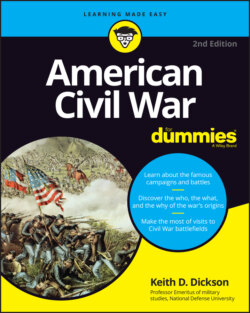Читать книгу American Civil War For Dummies - Keith D. Dickson - Страница 17
The Opposing Sides
ОглавлениеThe North and the South agreed on one thing: that the future of America lay in the vast open territory of the West. The troubling question was which section of the country would determine the nation’s destiny? Most of this territory had been won from Mexico after the Mexican-American War in 1846, and Northerners and Southerners disagreed over the future organization of this territory into states. The road to war began with a political struggle between the North and the South over how the western territories would be organized into states and enter the Union. This political struggle had its origins in the extensive social changes influencing the North after 1830. A religious revival known as the Second Great Awakening swept from New England into the new states of the Midwest with a message of moral revival and striving for individual perfection. Adherents believed that not only should men and women seek spiritual and personal purity through hard work and personal rectitude, but the whole of society must also be purged of unwholesome elements. Two of the most prominent threats to achieving this perfection in society were the moral evils of liquor and of slavery. Prohibition movements sprang up throughout the North, as did a movement to abolish slavery. Although these movements were not entirely popular in the North, they gained wider and deeper influence in the realm of politics.
Another powerful idea that shaped attitudes of Northerners was the notion of free labor. The future of America was a land of free white men who would move west and build happy and prosperous lives from their own efforts. This powerful vision also gained influence within Northern political circles, even to the extent of creating a new sectional political party, the Free Soil Party. Increasingly, the South was perceived as being a barrier to the limitless potential that a morally perfect country of free individuals could enjoy. Many in the North perceived Southerners as morally unfit, tainted by slavery, an institution that degraded small farmer and planter alike, making them listless, dull-witted, cruel, and violent. For Southerners, the writing was on the wall. In their vision of the future of America, the prosperity of the cotton economy would naturally expand westward. Cotton depleted the soil, requiring expansion westward to put more land into production. Without this expansion, the Southern economy would be condemned to a slow death. Of course, the westward expansion of the cotton economy meant that Southerners expected to bring slaves into the new territories.
Free labor became the catchphrase that heightened political divisions in the country. Only free (not slave) men could ensure a golden future for America. By extension, this meant that slave labor was neither legitimate nor welcome in the great West. Slavery, therefore, had to be limited and eventually destroyed if America was to fulfill its destiny. This concept had nothing to do with the status of Black men — free or otherwise — they had no place in this vision of the future. Southerners, hearing this message, and sensing that it was gaining political momentum, quickly recognized the threat to their own future in America, a place where the free labor advocates said they had no part to play.
